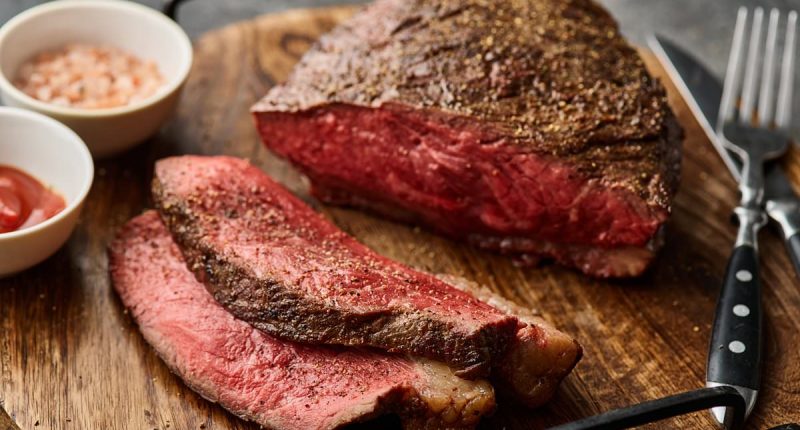Share this @internewscast.com
I was 15 before I had my first hamburger.
No, I’m not joking, but I’ve never been a big fan of red meat.
As a kid it was always McNuggets over the Big Mac, and even now, I almost always pick chicken or fish as my protein.
Part of that is personal preference, but nowadays, much of it is because of my experience as a health journalist covering the constant slew of research disparaging red meat (and heavily processed meats like bacon, sausage and hot dogs).
Over the years, studies have linked diets high in red and/or heavily processed meats to heart attacks, stroke, colon cancer and even dementia.
In the shorter term, high levels of saturated fat and sodium in many of these foods have been shown to raise cholesterol and clog arteries.
But recently, there has been conflicting research suggesting red meat has gotten a bad rap and the risks might be overblown.
I decided to put the science to the test and see if incorporating both red and more heavily processed meats into my daily diet would have an impact on someone who normally steers clear.

I’ve spent the last seven years writing about the health woes of both red and heavily processed meats. I decided to put the science to the test for a month
For the whole of February, I swapped at least one serving per day of my go-to proteins with a serving of red or more heavily processed meat.
This included steak, bacon, lamb, sausage and ground beef, among others.
Because some science tells us diets consisting only of animal products like red meat and dairy is a surefire way to raise cholesterol, I wanted to make a point to mix each serving I had with whole grains, fruits and vegetables to avoid going to extremes.
Before embarking on this journey, I took a baseline blood test from IVDrips. The test showed my LDL (bad) cholesterol and fats called triglycerides were on the cusp of being too high.
This isn’t the first time I’ve had results like these, as they tend to fluctuate.
But left untreated, these levels could cause fat to build up in my arteries and increase my blood sugar, leading to diabetes and heart disease.
I also had low vitamin D, which comes from sunlight and foods like egg yolks and fatty fish, but I blamed it on the dreary winter weather keeping me cooped up inside.
Additionally, prior to changing my chicken and fish-focused diet, I was finding myself lethargic and just generally unmotivated, which I also blamed on the winter blues.
Once I started my experiment, I recognized a difference that showed up outside my body and inside my wallet.
As I passed by the poultry aisle in the grocery store and stocked up on ground beef, Italian sausage, bacon, steak and ground lamb, I immediately noticed the price jump.
A pound of ground beef at my local New York City grocery store costs about $9 compared to $7 for the same amount of ground chicken or turkey.


While I tried to eat most of my meals at home, I had an easy time finding red and more processed meats while out to eat. These included a ‘wall’ of bacon (left) and one of many charcuterie boards (right)


Pictured at left is a pasta I made with Italian sausage. At right is Mongolian beef with rice
Throughout the experiment, I tried to strike a balance between heavily and not heavily processed meats. If I made Greek lamb meatballs or a hamburger one night, for example, I’d add a serving of bacon or sausage to my breakfast the next day.
This is because recent research has started to draw a line between levels of processed meats.
Foods like bacon tend to have higher levels of sodium and potentially carcinogenic chemicals as opposed to animal proteins that go through less steps of manipulation to reach our plates.
A report published last year in NPJ Precision Oncology, for example, suggested heavily processed meats produce metabolites, which researchers said ‘feed’ cancer cells and ‘hijack’ normal cells in the colon, causing them to mutate and grow uncontrollably.
During the trial period, I also tried to eat most of my meals at home so I could better control portions. When I did choose to eat out, I found most restaurants had a pretty large variety of red meat to choose from.
I expected to feel run down and sluggish after swapping poultry for burgers, steak, sausages and hot dogs, but was surprised when I hardly noticed anything change.
There were some mild effects like indigestion and a bit of bloating if I had a particularly greasy meat, but other than just generally preferring poultry or fish, nothing seemed drastically different.
There were subtle pros and cons, however.
For one, it seemed like the winter blues brain fog I’d been wrestling with had dissipated slightly after my month of meat. This goes directly against recent studies that have tied red and heavily processed meats to cognitive decline.

A friend’s birthday party took me to a local barbecue joint, where I was able to mix sausages with turkey


While I don’t normally put meat in my breakfast, I stepped out of my comfort zone with bacon (left) and steak and eggs
One Harvard study, for example, found eating one serving of heavily processed meat – roughly two slices of bacon or a single sausage – daily for four decades was linked to a 13 percent increased risk of dementia.
While I seemed to clear up mentally, it’s unlikely that just a month of adding more red meat to my diet was the sole cure to my seasonal depression. It could also be due, in part, to the leafy greens and whole grains I added to most meals during the trial period – they’ve been shown to lower inflammation in the brain and improve mental clarity.
I also found myself not staying quite as full as I had while eating chicken, which could be due to the amount – rather than the type – of protein I was consuming.
The USDA estimates every three-ounce serving of chicken has roughly 31 grams of protein, while the same serving of ground beef contains 26 grams.
The experiment also got me to try some foods out of my comfort zone like a ‘wall’ of bacon appetizer at a local bar and flank steak stir fry. Still, by the end, I was a little sick of red meat.
At the end of the month I underwent a second blood test from the IVDrips team.
I expected my already borderline high cholesterol to skyrocket and my triglycerides to go up even more.
However, my LDL cholesterol actually decreased eight percent, and my triglycerides dropped by one-third. My HDL (good) cholesterol remained the same in both tests – I was both impressed and surprised.
The only metric that worsened after the month-long trial was my alkaline phosphatase, an enzyme in the liver and bile ducts. When found in excess, it has been tied to fatty liver disease, but when lacking, could be a sign of zinc or vitamin B12 deficiency.
Both zinc and vitamin B12 are often found in poultry and salmon, foods I’d largely sworn off for the past month.
While I’m not likely to completely overhaul my diet and strip out my favorite proteins, it’s possible red and processed meats aren’t the boogeymen I’ve been writing about all these years.
Still, I’ll stick to adding more steak and sausage to my diet gradually instead of giving up my beloved chicken and fish altogether.












